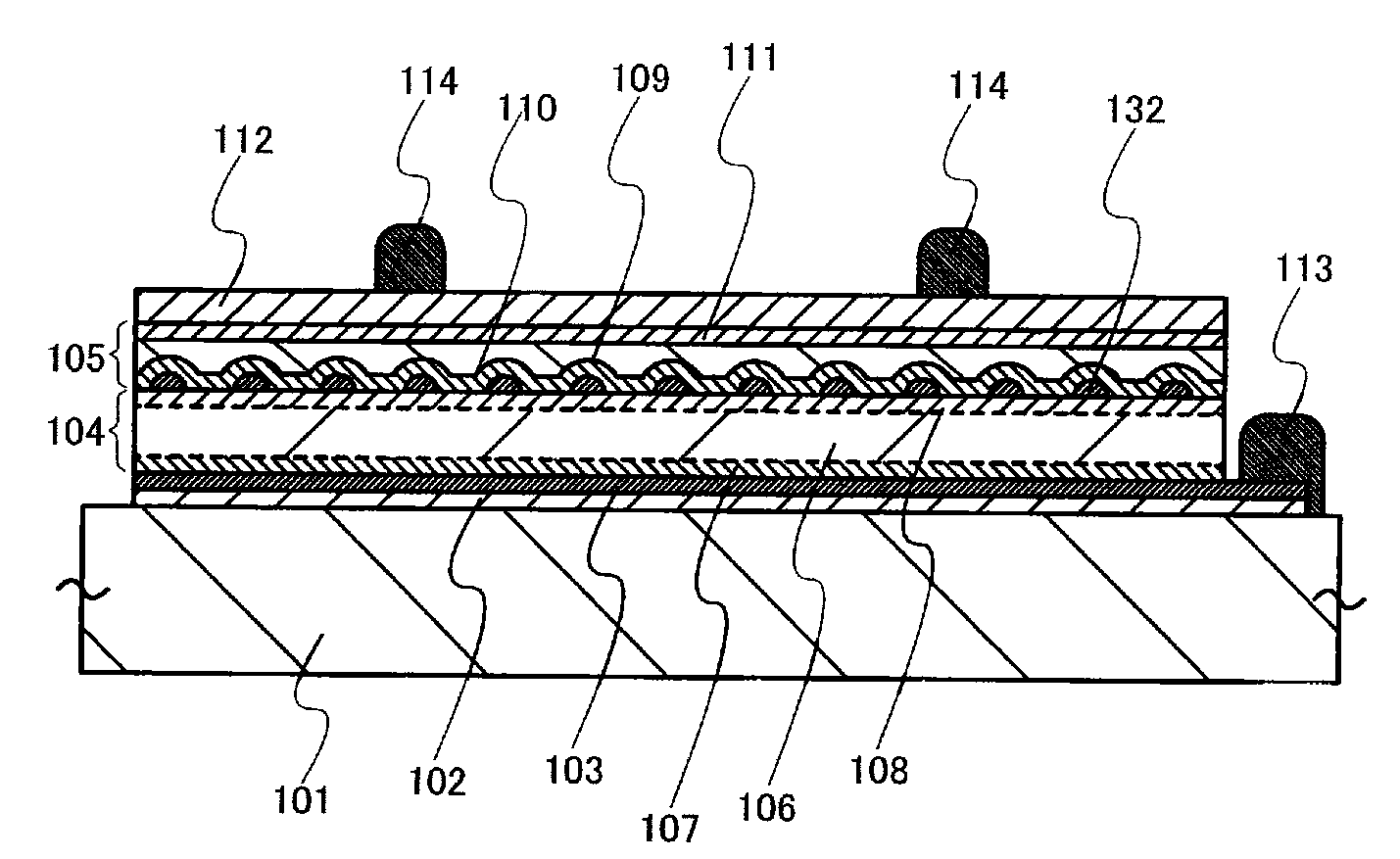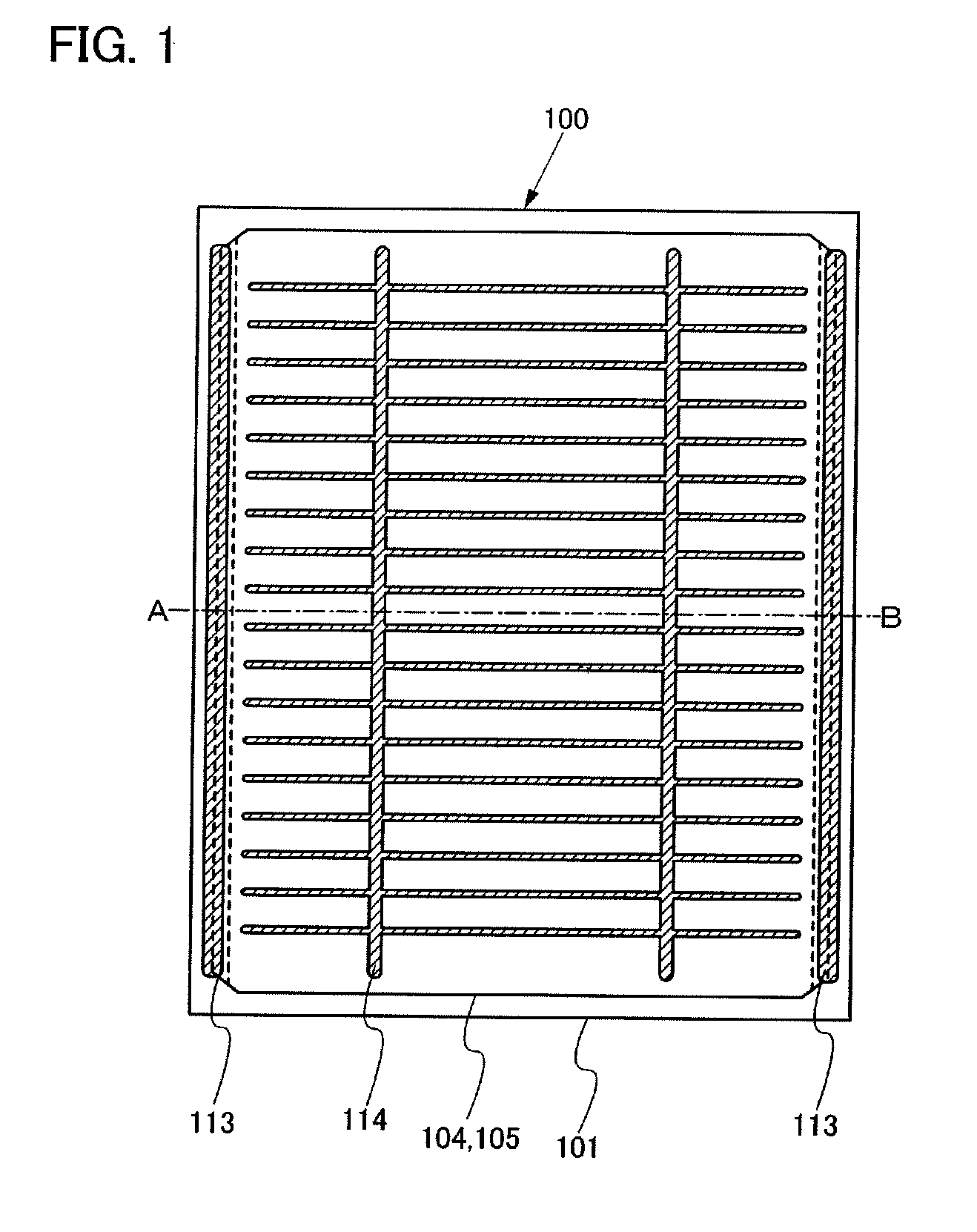Photoelectric conversion device and manufacturing method thereof
a technology manufacturing method, which is applied in the manufacture of final products, pv power plants, basic electric elements, etc., can solve the problems of reducing the productivity of photoelectric conversion device, the inability to efficiently use silicon semiconductors, and the inability to efficiently produce a sufficient number of photoelectric conversion devices. , to achieve the effect of reducing light loss, reducing production costs, and smooth flowing curren
- Summary
- Abstract
- Description
- Claims
- Application Information
AI Technical Summary
Benefits of technology
Problems solved by technology
Method used
Image
Examples
embodiment mode 1
[0042]FIG. 1 is a plan view of a photoelectric conversion device 100 of this embodiment mode. This photoelectric conversion device 100 is provided with a first unit cell 104 and a second unit cell 105 which are fixed onto a supporting substrate 101. The first unit cell 104 and the second unit cell 105 include a semiconductor junction, and accordingly photoelectric conversion is performed by the semiconductor junction. Note that conductive clusters are dispersed between the first unit cell 104 and the second unit cell 105.
[0043]A first electrode is provided on the supporting substrate 101 side of the first unit cell 104, and a second electrode is provided on a surface side of the second unit cell 105. The first electrode is connected to a first auxiliary electrode 113. A second auxiliary electrode 114 is provided over the second electrode. The photoelectric conversion device 100 of this embodiment mode has a structure in which the first unit cell 104 and the second unit cell 105 are ...
embodiment mode 2
[0065]Next, a manufacturing method of the photoelectric conversion device 100 will be described on the premise of the case of FIG. 2 as a cross-sectional structure taken along the line A-B of FIG. 1.
[0066]A semiconductor substrate 119 shown in FIG. 5A is cut off from a circular single crystal semiconductor substrate to have a substantially quadrangular shape. Needless to say, the plane shape of the semiconductor substrate 119 is not particularly limited. However, in the case where a supporting substrate which forms a single crystal semiconductor layer is rectangular, the semiconductor substrate 119 is preferably substantially quadrangular. Single crystal silicon whose surface is mirror-polished is typically preferable for the semiconductor substrate 119. This is because the semiconductor substrate 119 is firmly attached to the supporting substrate with an insulating layer for bonding interposed therebetween. For example, a p-type single crystal silicon wafer with a resistance of app...
embodiment mode 3
[0101]In some cases, due to formation of the damaged layer 121, crystal defects remain at the surface of the single crystal semiconductor layer 106 which is exposed by separation of the semiconductor substrate 119 shown in FIG. 6B of Embodiment Mode 2. In that case, the surface part of the single crystal semiconductor layer 106 is preferably removed by etching. For the etching, dry etching or wet etching is performed. Further, in some cases, an uneven surface whose mean surface roughness (Ra) is 7 nm to 10 nm and whose largest difference in height between peak and valley (P-V) is 300 nm to 400 nm remains. Note that the “largest difference in height between peak and valley” in this specification refers to a difference in height between the peak and valley. The “peak” and the “valley” in this embodiment refer to a peak and a valley obtained by three-dimensional expansion of the “peak” and the “valley” defined by JIS B0101. The peak is represented by the highest part of the peaks of th...
PUM
 Login to View More
Login to View More Abstract
Description
Claims
Application Information
 Login to View More
Login to View More - R&D
- Intellectual Property
- Life Sciences
- Materials
- Tech Scout
- Unparalleled Data Quality
- Higher Quality Content
- 60% Fewer Hallucinations
Browse by: Latest US Patents, China's latest patents, Technical Efficacy Thesaurus, Application Domain, Technology Topic, Popular Technical Reports.
© 2025 PatSnap. All rights reserved.Legal|Privacy policy|Modern Slavery Act Transparency Statement|Sitemap|About US| Contact US: help@patsnap.com



